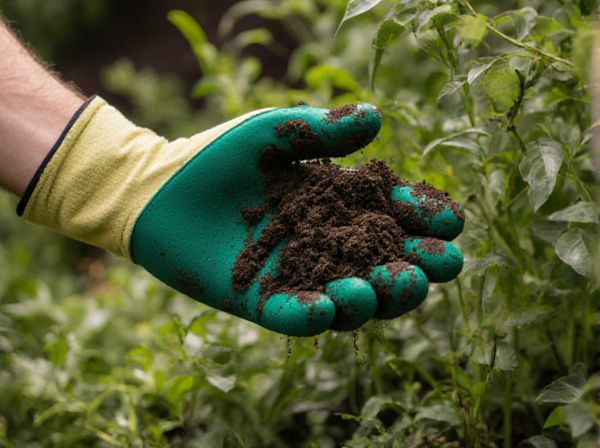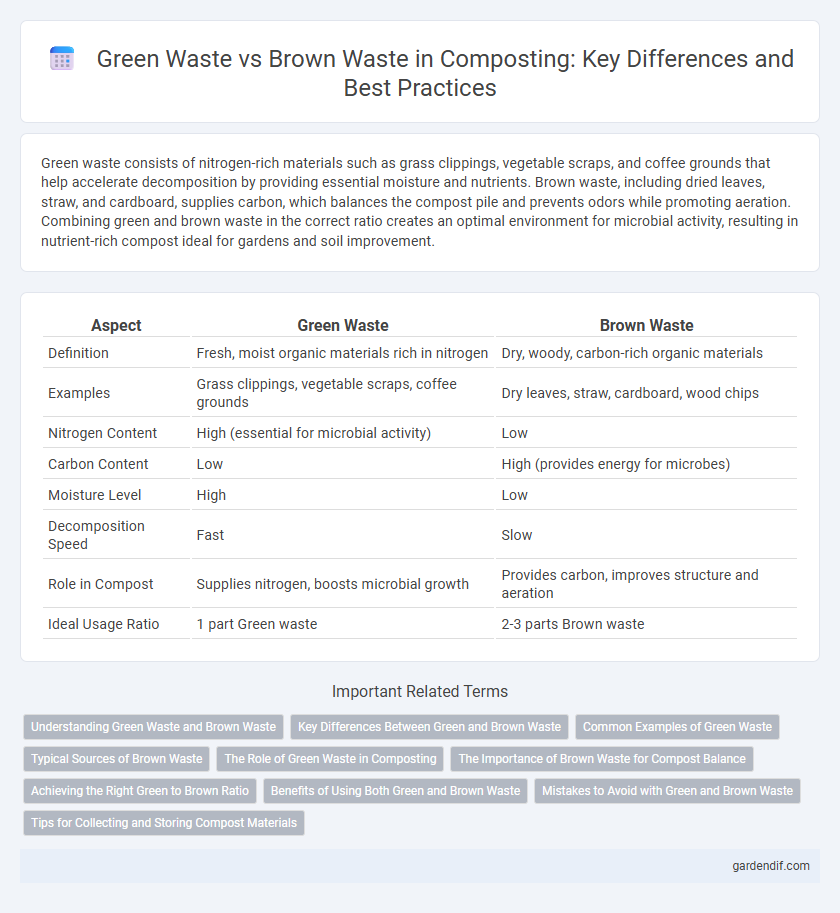
Green waste vs Brown waste Illustration
Green waste consists of nitrogen-rich materials such as grass clippings, vegetable scraps, and coffee grounds that help accelerate decomposition by providing essential moisture and nutrients. Brown waste, including dried leaves, straw, and cardboard, supplies carbon, which balances the compost pile and prevents odors while promoting aeration. Combining green and brown waste in the correct ratio creates an optimal environment for microbial activity, resulting in nutrient-rich compost ideal for gardens and soil improvement.
Table of Comparison
| Aspect | Green Waste | Brown Waste |
|---|---|---|
| Definition | Fresh, moist organic materials rich in nitrogen | Dry, woody, carbon-rich organic materials |
| Examples | Grass clippings, vegetable scraps, coffee grounds | Dry leaves, straw, cardboard, wood chips |
| Nitrogen Content | High (essential for microbial activity) | Low |
| Carbon Content | Low | High (provides energy for microbes) |
| Moisture Level | High | Low |
| Decomposition Speed | Fast | Slow |
| Role in Compost | Supplies nitrogen, boosts microbial growth | Provides carbon, improves structure and aeration |
| Ideal Usage Ratio | 1 part Green waste | 2-3 parts Brown waste |
Understanding Green Waste and Brown Waste
Green waste consists of nitrogen-rich materials such as fresh grass clippings, vegetable scraps, and coffee grounds that accelerate the composting process by providing essential nutrients. Brown waste includes carbon-rich components like dried leaves, straw, and cardboard that create structure and aeration, balancing moisture and preventing odor. Proper composting requires mixing green and brown waste in an optimal carbon-to-nitrogen ratio around 30:1 to enhance microbial activity and produce nutrient-rich soil amendments.
Key Differences Between Green and Brown Waste
Green waste consists primarily of nitrogen-rich materials such as grass clippings, fruit and vegetable scraps, and coffee grounds, which accelerate decomposition and provide essential nutrients for compost microbes. Brown waste, rich in carbon, includes dry leaves, straw, cardboard, and wood chips, contributing structure and aeration to the compost pile, preventing odor and promoting efficient breakdown. Balancing the ideal carbon-to-nitrogen ratio of about 30:1 by mixing green and brown waste ensures optimal microbial activity and faster composting results.
Common Examples of Green Waste
Common examples of green waste in composting include grass clippings, kitchen vegetable scraps, coffee grounds, and fresh plant trimmings. These materials are rich in nitrogen, essential for accelerating microbial activity and decomposing organic matter efficiently. Incorporating green waste balances the carbon-to-nitrogen ratio when combined with brown waste like dried leaves or straw.
Typical Sources of Brown Waste
Typical sources of brown waste in composting include dry leaves, straw, cardboard, sawdust, and wood chips, which provide essential carbon for microbial activity. These materials are crucial for balancing the high nitrogen content found in green waste like grass clippings and food scraps. Proper layering of brown waste ensures aeration and temperature regulation, promoting efficient decomposition and nutrient-rich compost production.
The Role of Green Waste in Composting
Green waste, rich in nitrogen, plays a crucial role in composting by accelerating microbial activity and breaking down organic materials efficiently. This nutrient-dense component balances the high carbon content found in brown waste, creating an ideal environment for decomposition. Proper integration of green waste enhances moisture retention and aeration, resulting in nutrient-rich, fertile compost.
The Importance of Brown Waste for Compost Balance
Brown waste, such as dried leaves, straw, and cardboard, plays a crucial role in compost by providing essential carbon that balances the nitrogen-rich green waste like food scraps and grass clippings. This carbon-to-nitrogen ratio ensures optimal microbial activity, promoting efficient decomposition and preventing foul odors. Maintaining the right balance between brown and green waste accelerates nutrient-rich humus formation, enhancing soil health and fertility.
Achieving the Right Green to Brown Ratio
Achieving the right green to brown ratio in composting involves balancing nitrogen-rich green waste such as vegetable scraps and grass clippings with carbon-rich brown waste like dry leaves and straw. Optimal compost mixtures typically consist of a 2:1 or 3:1 ratio of brown to green materials to promote efficient decomposition and prevent odor issues. Proper balance ensures microbial activity thrives, accelerating the breakdown process and resulting in nutrient-rich, healthy compost suitable for gardening and soil improvement.
Benefits of Using Both Green and Brown Waste
Combining green waste, rich in nitrogen, with brown waste, high in carbon, creates an ideal balance for composting, accelerating microbial activity and decomposition. This synergy enhances nutrient availability, resulting in richer, more fertile compost that improves soil structure and moisture retention. Using both types of waste reduces landfill burden and greenhouse gas emissions, promoting sustainable waste management practices.
Mistakes to Avoid with Green and Brown Waste
Mistakes to avoid with green and brown waste include improperly balancing their ratios, as too much green waste like grass clippings or kitchen scraps can cause odor problems and slow decomposition, while excessive brown waste such as dry leaves or cardboard can lead to poor moisture retention and slow down the composting process. Avoid adding diseased plants or treated wood to prevent harmful pathogens and chemicals from contaminating the compost. Ensure proper shredding of brown materials to increase surface area for microbial activity, promoting efficient breakdown and nutrient-rich compost production.
Tips for Collecting and Storing Compost Materials
Collecting green waste such as kitchen scraps, grass clippings, and fresh leaves provides high nitrogen content essential for speedy decomposition, while brown waste like dry leaves, straw, and cardboard offers carbon needed for balanced composting. Store green materials in breathable containers or bins to prevent foul odors and accelerate breakdown, whereas brown waste should be kept dry and loosely piled to maintain aeration and deter mold. Regularly layering green and brown waste ensures optimal moisture and aeration, promoting efficient microbial activity for rich, nutrient-dense compost.
Green waste vs Brown waste Infographic

 gardendif.com
gardendif.com